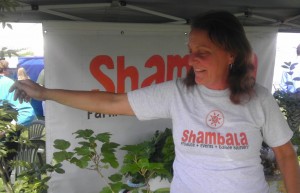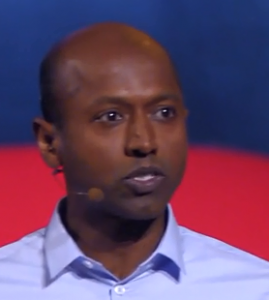Today marked the much anticipated opening of the Port Susan Farmers Market, our spot for showcasing the produce, flowers, honey, meats, milk, and nursery plants our local farmers have cultivated. It was well attended, with one booth selling out within the first hour. It’s now possible for me to do a full week’s organic and local grocery shopping in one place, while visiting with my neighbors, friends, and farmers.

Port Susan Farmers Market Opening Ceremony
It took a great deal of work to bring this, (and you’ll excuse the pun), to fruition. Slow Food Port Susan, the city of Stanwood, the Food and Farming Center, and local businesses all pitched in to make this market possible. It would not have happened without Leslie Collins, the market manager. She, along with numerous volunteers, worked diligently to coordinate vendors, find a suitable venue, create and disseminate marketing materials, ensure proper permits, and even paint a huge mural for the market backdrop.

The market’s mural created by the Stanwood-Camano Arts Guild.
The mural signifies, more than almost anything else, that the market is going to be a fixture in our community for more than just this year. I believe that the market is an important step in making our town sustainable and creating that sense of community so crucial to a vibrant, healthy place to live. As the Stanwood-Camano Island area grows in population, it’s important to guide how we want the community to look in the coming years.

Nancy Chase shows off the plants and produce from Shambala Farm.
Of course, I picked up some great food, too. Balanced System Farm had whole, organic, free-range, heirloom chickens for sale. I picked up some beets and beet greens, along with a huge bunch of carrots from Freshly Doug Vegetables. Cat’s Paw Honey had their delightfully hand-painted jars of honey on display, while Old Silvana Creamery sold milk from their Guernsey cows. Shambala Farms displayed not only produce, but many of the plants used in the type of permaculture in which they excel.

Vivian Henderson, with Slow Food Port Susan, had information on the Slow Food Roots Music Festival happening in Stanwood, Aug 25-26.
Another critical aspect of the market is introducing folks to the local farms and the events they are hosting during the rest of the summer. What a fantastic way to bring people who are already interested in fresh, healthy foods out to the farms that produce them? Besides strengthening our community, these farm events teach kids where food comes from. I think that’s fairly important.
Farmers Markets have been welcomed in many towns. Some critics, however, say they cater to only the elite or are insubstantial when it comes to feeding the world and, especially, feeding those who don’t have enough. I think they are missing the point altogether. Farmers Markets help create and invigorate the communities around them and give the poorest among us access to fresh, local produce at a decent price. (Many low-income food programs include farmers markets.) They bolster not only the incomes of farmers who sell directly to the consumer, they allow farmers to reach customers for their CSAs and other farm programs. Farmers markets become an important lynch pin in the link between town and country, between producer and consumer.
I believe that the Port Susan Farmers Market is a major step in creating the urban-rural connection we need to ensure the sustainability of our town and the health of our people. For those who still doubt that these markets are viable, I just point them to the big farmers market on Pike Street, in Seattle, which has been running for over a century. That usually settles any dispute.





